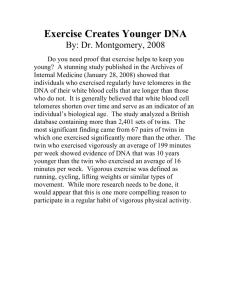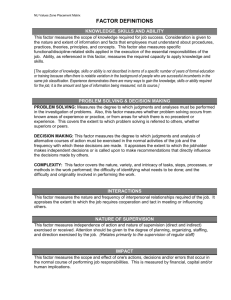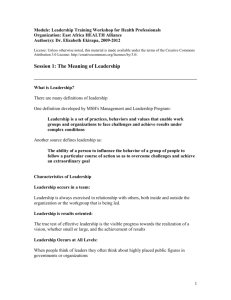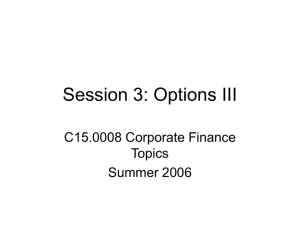1 CHAPTER 22 Real Options Answers to Practice Questions 1. a. A
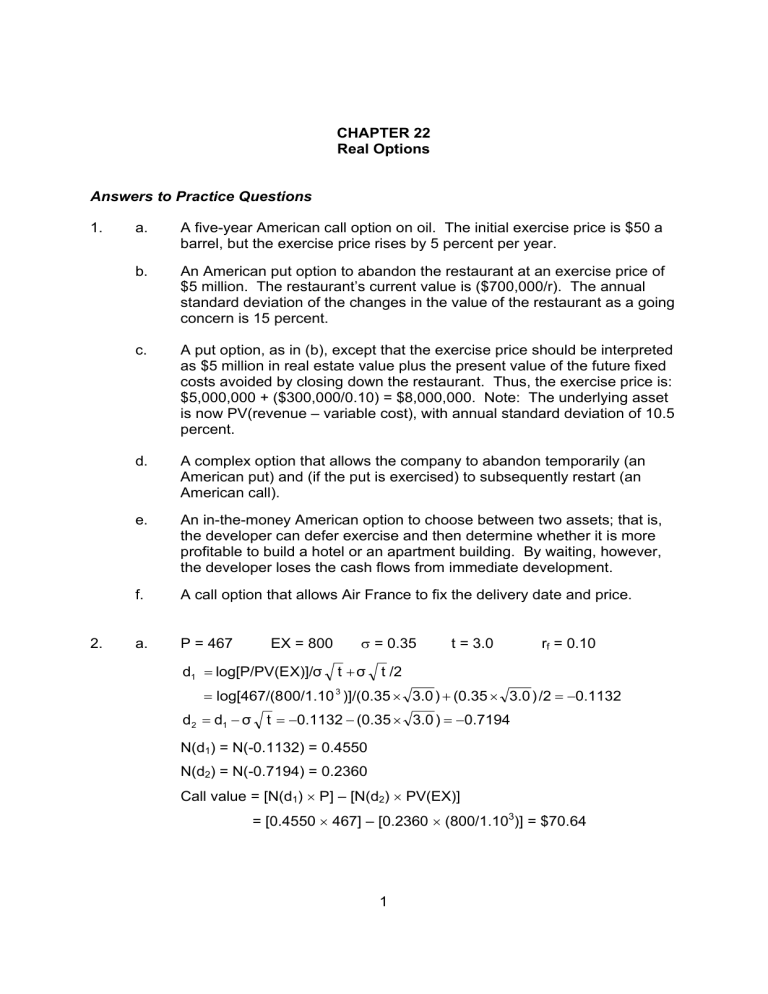
CHAPTER 22
Real Options
Answers to Practice Questions
1. a. A five-year American call option on oil. The initial exercise price is $50 a barrel, but the exercise price rises by 5 percent per year. b. An American put option to abandon the restaurant at an exercise price of
$5 million. The restaurant’s current value is ($700,000/r). The annual standard deviation of the changes in the value of the restaurant as a going concern is 15 percent. c. A put option, as in (b), except that the exercise price should be interpreted as $5 million in real estate value plus the present value of the future fixed costs avoided by closing down the restaurant. Thus, the exercise price is:
$5,000,000 + ($300,000/0.10) = $8,000,000. Note: The underlying asset is now PV(revenue – variable cost), with annual standard deviation of 10.5 percent. d. A complex option that allows the company to abandon temporarily (an
American put) and (if the put is exercised) to subsequently restart (an
American call). e. An in-the-money American option to choose between two assets; that is, the developer can defer exercise and then determine whether it is more profitable to build a hotel or an apartment building. By waiting, however, the developer loses the cash flows from immediate development. f. A call option that allows Air France to fix the delivery date and price.
2. a. P = 467 EX = 800 σ = 0.35 t = 3.0 r f
= 0.10 d
1
= log[P/PV(E X)]/ σ t + σ t /2
= log[467/(8 00/1.10
3 )]/(0.35
× d
2
= d
1
− σ t = − 0.1132
− (0.35
×
3.0
) + (0.35
×
3.0
) = − 0.7194
3.0
) /2 = − 0.1132
N(d
1
) = N(-0.1132) = 0.4550
N(d
2
) = N(-0.7194) = 0.2360
Call value = [N(d
1
) × P] – [N(d
2
) × PV(EX)]
[0.4550 × (800/1.10
3 )] = $70.64
1
b. P = 500 EX = 900 σ = 0.35 t = 3.0 r f
= 0.10 d
1
= log[P/PV(E X)]/ σ t + σ t /2
= log[500/(9 00/1.10
3 )]/(0.35
× d
2
= d
1
− σ t = − 0.1948
− (0.35
×
3.0
) + (0.35
×
3.0
) = − 0.8010
3.0
) /2 = − 0.1948
N(d
1
) = N(-0.1948) = 0.4228
N(d
2
) = N(-0.8010) = 0.2116
Call value = [N(d
1
) × P] – [N(d
2
) × PV(EX)]
[0.4228 × (900/1.10
3 )] = $68.33 c. P = 467 EX = 900 σ = 0.20 t = 3.0 r f
= 0.10 d
1
= log[P/PV(E X)]/ σ t + σ t /2
= log[467/(9 00/1.10
3 )]/(0.20
× d
2
= d
1
− σ t = − 0.8953
− (0.20
×
3.0
) + (0.20
×
3.0
) = − 1.2417
3.0
) /2 = − 0.8953
N(d
1
) = N(-0.8953) = 0.1853
N(d
2
) = N(-1.2417) = 0.1072
3. P = 1.7
Call value = [N(d
1
) × P] – [N(d
2
) × PV(EX)]
[0.1853 × (900/1.10
3 )] = $14.07
EX = 2 σ = 0.15 t = 1.0 r f
= 0.12 d
1
= log[P/PV(E X)]/ σ t + σ
= log[1.7/(2 /1.12
1 )]/(0.15
× d
2
= d
1
− σ t = t /2
1.0
− 0.2529
− (0.15
×
) + (0.15
× 1.0
) /2 = − 0.2529
1.0
) = − 0.4029
N(d
1
) = N(-0.2529) = 0.4002
N(d
2
) = N(-0.4029) = 0.3435
Call value = [N(d
1
) × P] – [N(d
2
) × PV(EX)]
[0.4002 × (2/1.12
1 )] = $0.0669 million or $66,900
2
4. The asset value from Practice Question 3 is now reduced by the present value of the rents:
PV(rents) = 0.15/1.12 = 0.134
Therefore, the asset value is now (1.7 – 0.134) = 1.566
P = 1.566 EX = 2 σ = 0.15 t = 1.0 r f
= 0.12 d
1
= log[P/PV(E X)]/ σ t + σ t /2
= log[1.566/ (2/1.12
1 )]/(0.15
× d
2
= d
1
− σ t = − 0.8003
− (0.15
×
1.0
) + (0.15
× 1.0
) /2 = − 0.8003
1.0
) = − 0.9503
N(d
1
) = N(-0.8003) = 0.2118
N(d
2
) = N(-0.9503) = 0.1710
Call value = [N(d
1
) × P] – [N(d
2
) × PV(EX)]
[0.2118 × (2/1.12
1 )] = $0.0263 million or $26,300
5. a. In general, an increase in variability increases the value of an option.
Hence, if the prices of both oil and gas were very variable, the option to burn either oil or gas would be more valuable. b. If the prices of coal and gas were highly correlated, then there would be minimal advantage to shifting from one to the other, and hence, the option would be less valuable.
3
6. a. The values in the binomial tree below are the ex-dividend values, with the option values shown in parentheses.
2700
(327)
2920
(491)
2405
(115)
3162
(712)
2605
(208)
2595
(202)
2136
(0)
3428 (978)
2825 (375)
2815 (365)
2318 (0)
2805 (355)
2309 (0)
2300 (0)
1892 (0) b. The option values in the binomial tree above are computed using the risk neutral method. Let p equal the probability of a rise in asset value. Then, if investors are risk-neutral: p (0.10) + (1 – p)(–0.0909) = 0.02
If, for example, asset value at month 6 is $3,162 (this is the value after the
$50 cash flow is paid to the current owners), then the option value will be:
[(0.419 × 978)]/1.02 = $711
If the option is exercised at month 6 when asset value is $3,212 then the option value is: $3,212 – $2,500 = $712
Therefore, the option value is $712.
At each asset value in month 3 and in month 6, the option value if the option is not exercised is greater than or equal to the option value if the option is exercised. (The one minor exception here is the calculation above where we show that the value is $712 if the option is exercised and
$711 if it is not exercised. Due to rounding, this difference does not affect any of our results and conclusions.) Therefore, under the condition specified in part (b), you should not exercise the option now because its value if not exercised ($327) is greater than its value if exercised ($200).
4
c. If you exercise the option early, it is worth the with-dividend value less
$2,500. For example, if you exercise in month 3 when the with-dividend value is $2,970, the option would be worth: ($2,970 - $2,500) = $470.
Since the option is worth $491 if not exercised, you are better off keeping the option open. At each point before month 9, the option is worth more unexercised than exercised. (As noted above in part (b) there is one minor exception to this conclusion.) Therefore, you should wait rather than exercise today. The value of the option today is $327, as shown in the binomial tree above.
7. a. Technology B is equivalent to Technology A less a certain payment of
$0.5 million. Since PV(A) = $11.5 million then, ignoring abandonment value:
PV(B) = PV(A) – PV(certain $0.5 million)
= $11.5 million – ($0.5 million/1.07) = $11.03 million b. Assume that, if you abandon Technology B, you receive the $10 million salvage value but no operating cash flows. Then, if demand is sluggish, you should exercise the put option and receive $10 million. If demand is buoyant, you should continue with the project and receive $18 million. So, in year 1, the put would be worth: ($10 million – $8 million) = $2 million if demand is sluggish and $0 if demand is buoyant.
We can value the put using the risk-neutral method. If demand is buoyant, then the gain in value is: ($18 million/$11.03 million) –1 = 63.2%
If demand is sluggish, the loss is: ($8 million/$11.03 million) – 1 = –27.5%
Let p equal the probability of a rise in asset value. Then, if investors are risk-neutral: p (0.632) + (1 - p)(-0.275) = 0.07
Therefore, the value of the option to abandon is:
[(0.62 × 2)]/1.07 = $0.71 million
5
8. a.
$28.08
$11.50
$14.38
$17.97
$11.97
$22.46
$14.97
$18.71
$18.71
$12.47
$12.47
$9.58
$9.97
$7.98
$8.31
$8.31
$6.65
$5.54
b. The only case in which one would want to abandon at the end of the year is if project value is $5.54 (i.e., if value declines in each of the four quarters). In this case, the value of the abandonment option would be:
($7 – $5.54) = $1.46
Let p equal the probability of a rise in asset value. Then, using the quarterly risk-free rate, we find that, if investors are risk-neutral: p (0.25) + (1 - p)(-0.167) = 0.017
The risk-neutral probability of a fall in value in each of the four quarters is:
0.441) 4 = 0.0976
The expected risk-neutral value of the abandonment option is:
The present value of the abandonment option is:
(0.0976
6
9. The valuation approach proposed by Josh Kidding will not give the right answer because it ignores the fact that the discount rate within the tree changes as time passes and the value of the project changes.
10. Live Excel problem; approaches will vary. However, answers should demonstrate the relationships identified in Table 20.2.
7
Challenge Questions
1. You don’t take delivery of the new plant until month 36. Think of the situation one month before completion. You have a call option to get the plant by paying the final month’s construction costs to the contractors. One month before that, you have an option on the option to buy the plant. The exercise price of this second call option is the construction cost in the next to last month. And so on.
Alternatively, you can think of the firm as agreeing to construction and putting the present value of the construction cost in an escrow account. Each month, the firm has the option to abandon the project and receive the unspent balance in the escrow account. Thus, in month 1, you have a put option on the project with an exercise price equal to the amount in the escrow account. If you do not exercise the put in month 1, you get another option to abandon it in month 2. The exercise price of this option is the amount in the escrow account in month 2. And so on.
2. a. An increase in PVGO increases the stock’s risk. Since PVGO is a portfolio of expansion options, it has higher risk than the risk of the assets currently in place. b. The cost of capital derived from the CAPM is not the correct hurdle rate for investments to expand the firm’s plant and equipment, or to introduce new products. The expected return will reflect the expected return on the real options as well as the assets in place. Consequently, the rate will be too high.
8
